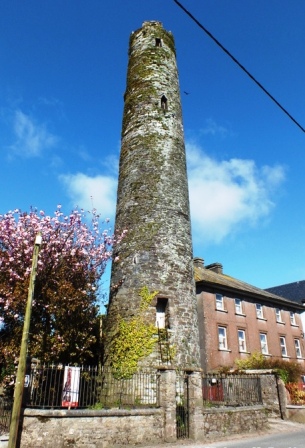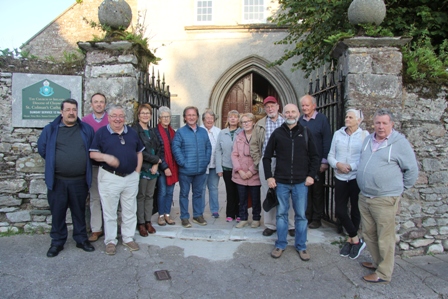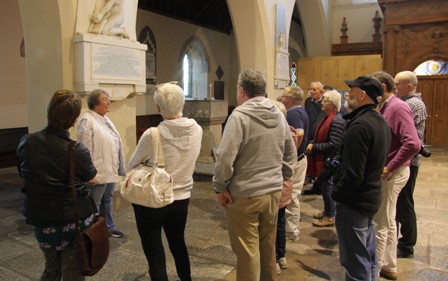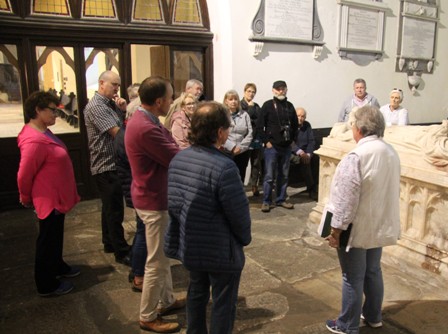Lectures by Patricia Lyons
Guided Tour Cloyne
The Lecture
 Round Tour, Cloyne
Round Tour, Cloyne
On a beautiful late summer’s evening a small group of members and our guests gathered at Cloyne Cathedral where we
were met by Patricia Lyons, the local parish historian, a member of the Cloyne Literary and Historical Society,
who gave us an informative, and very interesting guided tour. Our usual events fee collected on the day was donated
in its entirety to the Cloyne Cathedral restoration fund by Patricia.
While on the adjoining burial grounds, this tour began by Patricia advising us of the relationship between the Round
Tower (one of the town's landmarks), and explained how the site had been a place of worships since the time of St
Colman, who was granted the lands by the King of Cashel, circa 530AD, where he established his monastery in Cloyne.
Next to arrive were the Cistercians who established their Monastery on the site of the much developed Cloyne Cathedral
of the Established Church.
Then our attention was directed towards the various peculiarities of the Cathedral construction itself, and the material
used; some of which could possibly have been recycled from the Cistercian Monastery such as the north door frame with
ancient carvings etched upon it, which could be clearly seen to this day. Old etchings of the Cathedral show different
window surrounds to those of today. From the exterior it may be observed at least two structures with different roof
levels, although it could conceivably be more than this.
Upon entering through this ancient doorway, we were faced with an enormous open space of the Nave, an area of the
Cathedral with a floor covered with equally ancient flagstones; some of which had old inscription etched upon them.
Patricia commented that even now, on occasion new etchings or inscription are still being found.Some of these flagstones
also serve as grave makes for those interred beneath them. Once inside, and looking up it may be observed how corbel
stones projecting into the aisles serve no function today as the current roof is several feet high. Then to our utter
astonishment, Patricia explained how the Church was not sitting on any form of foundations, and that at times water can
be seen rising through the floor. The next, and rather quirky observation are the pillars of the arched roof supports.
They are not aligned.
Baptismal font and memorials
We then moved into the South Transept once known as the Poore Aisle, now the Longfield/Ponsonby chapel, a rather
cold and unassuming location, in want of serious repair. Here are buried many of the of Fitzgerald and Mountifort
Longfield families of ancient and recent times. Crossing over to the North Transept, formerly known as the Fitzgerald
chapel, now the Berkeley chapel, a beautifully kept location dedicated to Bishop Berkeley. Here also on display are a
number of manuscripts and artefacts of the MV Sirius of Passage West.
Patricia concluded her tour in very well-kept Chancel, another beautiful part of the Cathedral which serves today’s
much depleted congregation. The furniture, Organ, and pews. Here again she pointed out the influence of the Cistercian’s
which may be still observed with the pews facing each other as in a monastery.
On the south wall is an image of the original Pipe Roll Parchment of Cloyne, which recorded a number of events from
1237 forward. It is was housed Dublin Records Office, but was a victim of the disastrous fire of 1922 after the
bombardment. On the opposite wall is an image of the so called “Cross of Cloyne”, found in the graveyard, and was
presented to the Cathedral by the Cloyne Literary & Historical Society in 1985. The original was given to the National
Museum in 1885. It is a cross of guilt bronze from the 11th/12th century, 11.8cm in length. Each
arm depicting figures of Christ it is believed, all in different positions. It is thought to resemble a manuscript clap.
Our Photos of the Day

|

|

|
| Our Arrival at Cloyne |
Patricia telling us about the interior |
Berkley dedicated North Chancel |